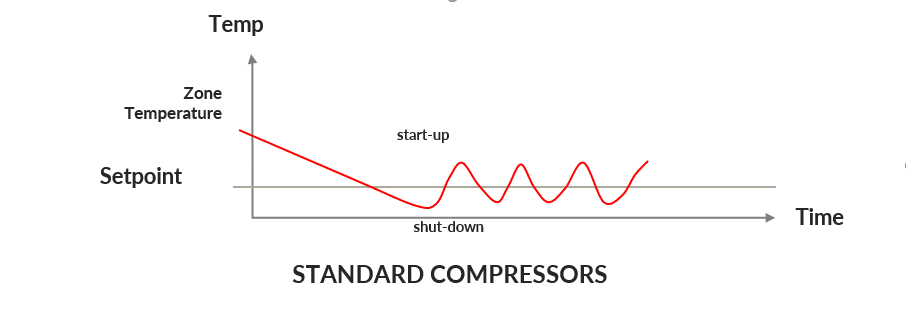VARIABLE SPEED
TECHNOLOGY FOR HVAC
WHY ARE ALL THE HVAC MANUFACTURERS INVESTING IN VARIABLE SPEED TECHNOLOGY?
Because it is the future by offering numerous benefits that increase energy efficiency and reduce utility costs.
HVAC is not the first industry to make this change… the auto industry made a similar transition in the 1980s to improve car product performance. The same thing is happening today in the HVAC industry.
Furthermore, consider variable speed technology as matching the HVAC equipment’s output to the home’s needs. How many people have a car with one gear? Or a stereo with one sound setting? No one does because you want the ability to match the output of the equipment to the changing demands of the space or application. By leveraging variable speed technology for HVAC, we are doing the same thing, just applying it to your home’s comfort controls
So how does variable speed impact your HVAC system?
Variable speed delivers the precise amount of cooling or heating required for your desired temperature or humidity setting. This means you will have fewer temperature or humidity spikes to mitigate by adjusting your thermostat and initiating another cycle on your system. With a variable-speed compressor, the system has longer run times, reducing the number of starts and stops on your system. This change in how the system runs results in less wear and tear on the components because start-up and shutdown modes tend to be the hardest on the unit and reduced electricity consumption because usage surges when an HVAC system turns on. While longer run times might sound like increased energy costs, it is actually quite the opposite.
If the new unit has multiple stages, the system can run at a lower capacity stage to maintain your desired temperature. So unlike single-stage units that run at 100% all the time, a variable speed, multiple-stage unit can run at 20% power with the same effectiveness. According to a study by the Department of Energy, “Operating fan motors or compressors at lower speeds for longer periods can lead to reduced total energy consumption.”1 This is why air conditioners or heat pumps with compressors that can run at lower speeds for a longer period of time may actually use less energy than equipment with only one, 100% speed option.
Standard Compressor Workload

This picture demonstrates how the temperature in your home can fluctuate when using a standard HVAC system to cool your home. While you set your desired temperature, you will see significant fluctuations when the unit starts and stops.
While this graph isn’t illustrating the energy usage of the standard Air Conditioning unit, the graph illustrates the same pattern. The standard system runs at 100% all the time, which causes more frequent starts and stops to try and maintain the desired temperature level. Because of this, your system has to cool itself at every start-up, which utilizes a lot of energy only to have the system run for a short time and then turn off. These short-run cycles also cause more wear and tear on your system because every shutdown is hard on the AC unit.
Variable Compressor Workload

In this illustration, you will still see that the system can ramp up to cool the home to the desired temperature and humidity level but then read the internal air quality to adapt the power usage to better maintain optimal comfort through longer run times and fewer start-up cycles.
This means that the air conditioner stays cool and requires less energy to cool the air running through the system. This change in technology causes less wear and tear on the components and allows it to last longer, and results in a better return on investment on top of energy savings of up to 30%.
More Benefits of Variable Technology
Tighter control of temperature and humidity
Another great benefit of variable-speed HVAC systems is the level of control you have over the temperature and humidity levels in your home. These systems sense both temperature and humidity and adjust their output to focus on the current demands. This is important because the humidity level in the house makes a significant difference in the “feels like” temperature. With better control over the humidity settings, the temperature can be increased with lower humidity, and the ‘feels like’ temperature remains the same and can result in more significant energy savings.
Enhanced Dehumidification
When temperatures are at their highest outside, once your home is comfortable, it is more energy efficient for the HVAC system to dehumidify the air rather than air conditioning it and decrease the temperature. A variable HVAC option removes up to 400% more moisture than a standard system. This means less cycling, longer run times, and optimized compressor and blower speeds.
Increased Air Quality
The extended run time afforded by variable speed units may increase the time for the air to circulate and interact with filters or additional air quality system components. This means the air in your home is more filtered and may contain fewer pollutants and airborne bacteria. However, as with traditional systems, it is vital to change out your air filters and indoor air quality essentials according to your HVAC dealer or manufacturer’s recommendations.
How do you know if an air conditioner or furnace is energy efficient?
There are several industry-regulated metrics to show contractors and consumers the energy efficiency of their HVAC system components. You may wonder what these ratings mean and why consumers should know their impact, so here is a quick summary. While you might see other ratings out there, the following three are the established standard for HVAC.
HSPF Rating:
is the Heating Seasonal Performance Factor and measures how efficiently your HVAC system uses electricity to heat your home. This measurement is important because it indicates how energy efficient the equipment is when maintaining heating comfort during the winter months.
EER Rating:
is the Energy Efficiency Ratio and measures the ratio of useful cooling output (in BTU/h) to electricity input (measured in W). When it comes to air conditioning units, this is typically seen as the most important rating because it is a good indication of the potential energy savings for cooling your home.
SEER Rating:
is the Seasonal Energy Efficiency Ratio and measures the energy efficiency of an HVAC system. It is important because it provides insight into the annual energy consumption and efficiency of the unit’s cooling ability in typical day-to-day use. The higher the SEER value, the less energy the unit will use.
How do you get a variable system for your home?
Superior Service is a Bryant Factory Authorized Dealer. Bryant heating and cooling systems lead the industry with variable speed and stage units with the best SEER, EER, and HSPF ratings. Whether you are looking for a complete HVAC system or considering switching to a heat pump, our Comfort Specialists can craft a perfect solution for your home and specific needs. There are also financing options at little as 0% for 72 months, and you can save as much as $5,825 in credits and rebates2.
To understand which system would work best in your home, contact one of our Comfort Specialists to schedule an appointment and get more information.
Schedule today for your FREE Estimate!
Give us a call or complete the form below to get an appointment that works best for your schedule.
Call our office or fill out the online form.
"*" indicates required fields





